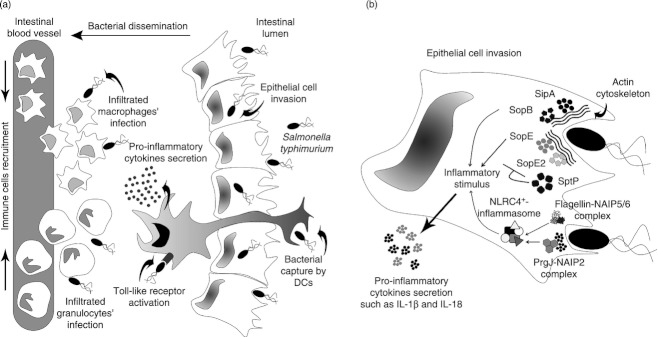Figure 1.
Lamina propria invasion and inflammatory immune response during Salmonella enterica Typhimurium infection. (a) Once Salmonella arrives at the lamina propria (LP), it can traverse cell intestinal layers and cause cytokine secretion and immune cells recruitment. Intestinal dendritic cells (DCs) can sample the pathogen, so enhancing the inflammatory environment by Toll-like receptor (TLR) activation after pathogen-associated molecular pattern (PAMP) recognition. Different types of cells, such as granulocytes and macrophages, can reach the site of infection increasing both the infiltrate and the acute gastroenteritis. (b) Salmonella pathogenicity island 1 (SPI-1) -derived proteins responsible for epithelial cell invasion during LP infection. After Salmonella recognize epithelial cell surface, SPI-1-encoded proteins are expressed and injected into host cells. Virulence effectors such as SipA, SopE, SopE2 and SopB are responsible for reorganizing actin cytoskeleton, promoting bacterial engulfment. Other SPI-1-secreted factors, such as SptP, decrease this process avoiding host cell death by excessive intracellular bacterial load. Proteins, such as flagellin and PrgJ can also be translocated into the host cell cytosol where they activate nucleotide oligomerization domain-like receptor (NLR)-containing inflammasomes to promote the secretion of inflammatory cytokines, including interleukin-1β (IL-1β) and IL-18.

